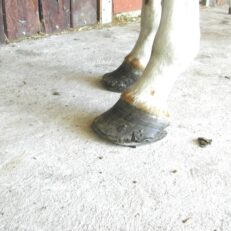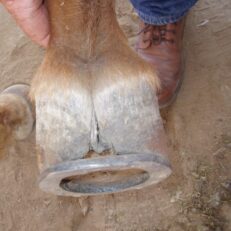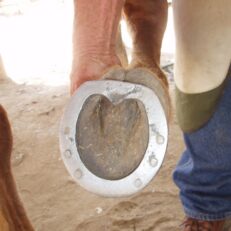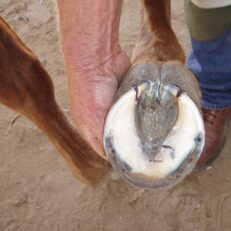I have lost count of the number of consultations over the last year where each owner has explained in great detail that the horse in question has to be shod with bar shoes and rolled toes or egg bars or wedged heels or something similar, because it was diagnosed with suspected navicular disease two or three years ago.
According to each owner’s lament, the horse is tripping and stumbling and has never really been sound; even x-rays which are sometimes years old were never really positive. If they were positive and there is navicular degeneration, the previously mentioned style of shoes may be appropriate and should be continued with. So what is the problem with these vague symptoms?
It is very important to fully understand the basic principles which may be causing stress to the navicular bone area and heels either side of it. As seen in Pic 1, the deep flexor tendon travels down the back of the leg and passes over the navicular bone then attaches to the underside of the pedal bone. Thus, if a hoof is at all long in the toe it will cause pressure at the heels and excessive tension in the deep flexor tendon where it passes over the navicular bone. High heels and short toes will also give the same indication due to concussion at the heels; the resulting effect is a lameness which outwardly looks like navicular disease, but is it really…?

The golden rule in problem solving is always go back to basics, and this is especially true with horses and lameness, but first of all listen to the owner and get all the historical information possible. Common symptoms of navicular disease are usually that the horse is disunited in its gait, rough to ride, stumbles a lot, has a sensitive back, forges and over reaches intermittently – also the horse is usually displaying a less than happy attitude. Many of these symptoms can also simply indicate unbalanced feet.
The majority of horses that I see with long term suspected navicular are simply horses that have been left too long between shoeing. This is an owner education problem and these horses need to be re-shod very regularly at no longer than four weekly intervals. This is to prevent any flaring or distortion in the toe area from causing pressure at the heels. To really understand this, try standing on a flat surface then put a two centimetre piece of wood under your toes and stand upright; you will notice that your weight is now all back on your heels just like the horse, so by stopping long toes and correcting any flares at the toe, it will also stop any excess weight on the heels which will then begin to grow properly, plus there should be an immediate improvement in the horse’s movement and attitude.
A horse which has upright pasterns will also often display signs of navicular soreness but for the opposite reason; it will be short in the toe and high in the heel and have a short proppy gait, as well as being rough to ride and inclined to stumble. On inspection you will see that the frog is small and also contracted, so the soreness is a combination of two problems – the high heels are causing the hoof to land too early, resulting in excess concussion of the heel buttresses and the high heels also prevent any frog contact with the ground so there is no cushioning.
In this case leave the toe alone and lower the heels down to the junction where the widest point of the frog meets the hoof capsule – you will see evidence of bruising at this point. In extreme cases this needs to done in stages a week or two apart, as the deep flexor tendon which has contracted will also need time to stretch. Now that the frog is in ground contact again, blood flow through the hoof will go back to normal and the toe will begin to reform.
Another common man made problem is to fit shoes which are too heavy to suit the bone structure of the horse, and leave them to hang out past the heel buttresses. This causes pressure and soreness under the shoe at the heel, which can also give the impression of navicular syndrome. In photo B, the toe has been left too long plus the heavy shoe extends back past the heel buttress.
The bottom line is that without the benefit of an up to date x-ray, a competent farrier must carry out a very accurate assessment and balance and correction on these suspected navicular cases before jumping in and shoeing the horse wrongly. In most of these horses I get to see, all they ever needed was to be trimmed correctly or shod with normal shoes. Ask the horse too – if it doesn’t look right the chances are it certainly doesn’t feel right either.
I recently came across one of the worst cases of inappropriate shoeing I have ever seen. The little horse was brought to me wearing frog bar shoes. I enquired why it was wearing these shoes and the owner explained that some time ago the horse had suspected navicular disease and the farrier had determined that for the rest of its life the horse should be shod with frog bar shoes. You can see the result in Pic 1 & 2. The horse had been shod recently, with handmade shoes.
On asking the owner, the horse only ever had suspected navicular disease; it was never physically and unequivocally diagnosed with navicular disease. But I suspect strongly that it had always had very high heels, and was more than likely suffering from shock in the heels, from the heels landing too early because they were too high.
The horse was about 14.2hh, quite upright in the pasterns, the result being that it will grow longer in the heels. However shoes like this totally stop the natural workings of the hoof, along with lifting the frog off the ground. As you can see in Pic 1 & 2 the shoe is hardly worn; it had only been on there about two weeks, so it had not regrown at this stage thus the hoof was actually prepared like this when these shoes were made new and fitted – it was this preparation that really upset me.
When I took the shoes off this horse and tried it with the hoof testers there was absolutely no sign of lameness in the navicular area at all. In Pics 2 & 3 & 4 you can see how far the heels have become constricted.
When I commented that I had never seen heels as contracted as these, the owner actually thought I was joking but it was true. Sadly, it was also said to me that there were a huge percentage of horses in that area that were being shod like this and had contracted heels like this. I genuinely had never seen heels so closed in on the frog. The width of the frog further forward, about an inch from the heel, is actually not too bad, but right back at the heel it was barely more than the width of my sole knife. If they had been let go any further you could just about have grafted the heels together and used them for a funnel.
The black lines that I have marked on the heels of the hoof in Pic 4 are actually where the buttresses of the heel should be if it was in true balance. The owners felt they should have the frog bar shoes put back on but I refused, and then set about convincing them of the folly of doing that. This hoof MUST get down on the ground and be given a chance to spread out and develop at both heels otherwise the horse will be unusable.
This is a classic example of why I have always believed that we should always learn to trim the hoof properly before we start making horseshoes. All the emphasis was put into making a fancy shoe without first:
A. Assessing the problem and then
B. Balancing and trimming the hoof properly to
C. Correct the problem.
Suspected navicular disease that is undiagnosed and unproven should sound a warning bell to look for the real problem.
Footnote: In 2014 the more modern x-ray machines have been able to pinpoint cysts not only on the navicular bone but also at the DDFT junction on P3. Diagnosis seems to be degenerative and not operable. However I believe in the Principle of Cause and Effect –
The Cause is the strain on that area of the DDFT and coffin bone in other words long toe/low heel. The Effect is the cyst and the resultant lameness.
The Resolution is to reduce any further damage by simply correctly balancing the hoof (and in severe cases by shortening the point of breakover).





